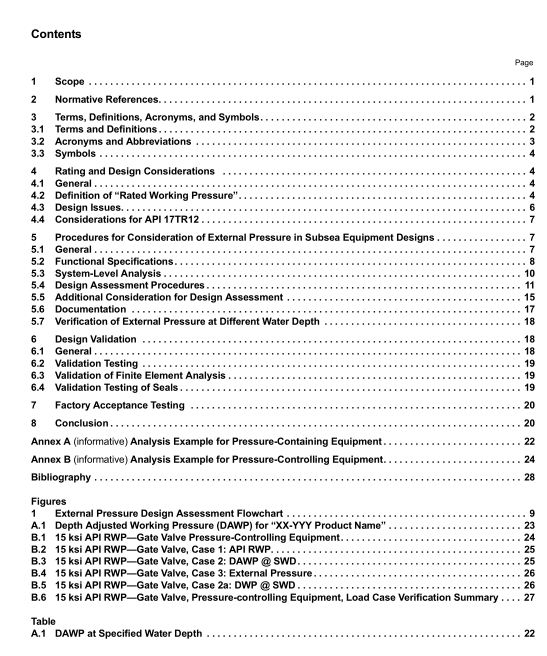API TR 17TR12 pdf download

API TR 17TR12 pdf download Consideration of External Pressure in the Design and Pressure Rating of Subsea Equipment
1 Scope
This technical report addresses issues related to the effects of external pressure acting on API Subcommittee 17(SC17, Subcommittee on Subsea Production Equipment) subsea equipment installed in deepwater for containing orcontrolling wellbore fluids.External pressure at deepwater can significantly reduce the differential pressure acting onthe wall of subsea equipment, and therefore, this can improve its internal pressure containment capability.Externalpressure is typically ambient seawater pressure, but in some cases,external pressure may be due to the hydrostatichead of drilling mud,completion fluids, or other fluids contained within risers or other conduits that connect the subseaequipment to surface facilities.
There is a need for guidelines on the application of external pressure during the design, validation and operation ofsubsea equipment. Guidelines are also needed to calculate andlor determine a modification to the working pressurelimits at the installed water depth, using the selected equipment API rated working pressure (RWP).
APl Technical Report 17TR12(hereafter API 17TR12) provides guidance for subsea equipment designersl/manufacturers to properly account for external pressure (or in some cases, differential pressure) when designing andvalidating subsea equipment. Additionally, this technical report provides guidance to equipment purchaserlend-userto appropriately select rated equipment for their subsea systems with consideration to the effects of external pressurein addition to internal pressure,including differential pressure across a closure mechanism, and other appliedmechanical or structural loads under all potential operating scenarios and functionality criteria.
NOTE API Technical Report 17TR4 (hereafter APl17TR4) provides additional information on the effects of external pressure onstresses generated within subsea equipment for the equipment designer.
API 17TR12 applies specifically to API SC17 equipment.APl 17TR12 is to be used as a supplement to theequipment’s applicable APl product specification (e.g. APl 6A API 17D,APl 17G), depending on its specificapplication, associated regulations,and project requirements. Other APl product specifications may elect to adoptthis technical report, subject to their component hardware,application-related design constraints and acceptancecriteria.Specific subsea recommended practices, standards, and/or specfications may elect to adopt this technicalreport, also subject to their component hardware and application-related design constraints.
For this technical report, the term “equipment”also applies to the terms “part , “component”‘ “sub-component’or”device” within a subsea system.
Normative References
The following referenced documents are indispensable for the application of this document. For dated references,only the edition cited applies. For undated references, the latest edition of the referenced document (including anyamendments) applies.
API Specification 6A, Specification for Wellhead and Christmas-Tree Equipment, Twentieth Edition, October 2010API Specification 17D,Design and Operation of Subsea Production Systems—Subsea Wellhead and TreeEquipment, Second Edition, May 2011
API Recommended Practice 17G, Recommended Practice for CompletionWWorkover Risers, Second Edition,July2006
3 Terms, Definitions, Acronyms, and Symbols3.1Terms and Definitions
For the purposes of this document, the following definitions apply.3.1.1
一名sss1sratea design by toastng to cemornmectc..n…
3.1.2
design verification (assessment)
Process of examining the result of a given design or development activity to determine conformity with specifiedrequirements.
3.1.3
depth adjusted working pressure
The maximum internal pressure a piece of equipment can contain and/or control with consideration of the equivalentexternal pressure at a specified water depth (measured in “psia” , absolute pressure).
3.1.4
differential working pressure
The difference between the upstream and downstream pressures on a pressure-controlling element that defines theworking pressure for the pressure-controlling equipment(measured in “psid” , differential pressure).
3.1.5
manufacturer (equipment)
Individual or organization that is normally responsible for the design and manufacture of the equipment.
3.1.6
operator
Individual or organization that normally uses the equipment (also referred to as “end-user”).
3.1.7
pressure
The ratio of force to the area over which that force is distributed (.e.pound-force applied to an area (in.2), measuredin “psi”, etc.):
1) absolute pressure: the internal pressure that the equipment is designed to contain andlor control or zero-referenced against a perfect vacuum, measured in “psia”;
2) differential pressure: the difference in pressure between any two points (p1 and p2), measured in “psid”;
3) gauge pressure: measured relative to the ambient pressure (e.g. atmospheric for surface application,hydrostatic for subsea application), measured in “psig”.
3.1.8
pressure-containing equipment
Part whose failure to function as intended results in a release of wellbore fluid to the environment.EXAMPLESubsea tree valve body, bonnet,stem.









